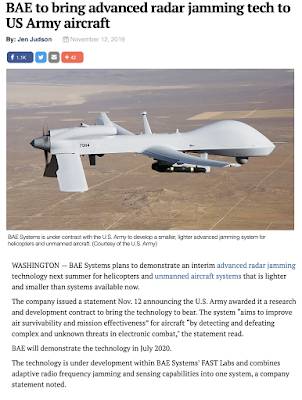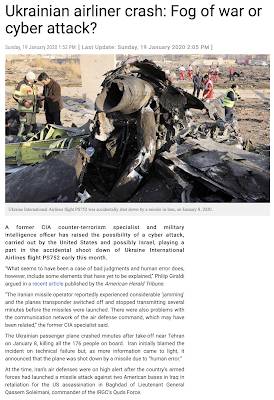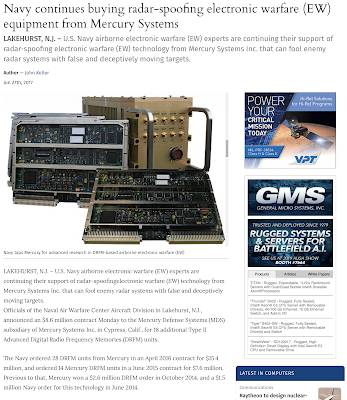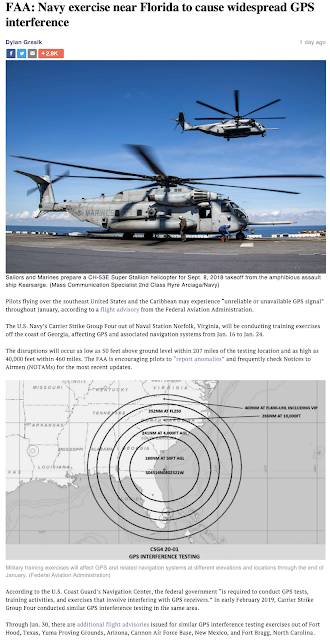
This relatively recent news item found on Defense News:
…lends credence to this news item from Iran's PressTV:
The Defense News item goes on to state that:
“Whereas today’s electronic countermeasure systems are too bulky and heavy for most rotary-wing and UAS platforms, BAE Systems technology will combine multiple, software-programmable antennas into a digital phased array that will enable simultaneous functions, exceeding existing capabilities while reducing the size, weight, and power of current systems,” according to the British company’s statement.
As the Army looks to modernize its capabilities to fight across multiple domains in highly contested environments, the technology, the company said, will enable the aircraft to fly closer to threats and remain protected."
According to an article by Philip Giraldi that appeared in the American Herald Tribune and was quoted in the PressTV coverage, we find the following:
"The electronic jamming coming from an unknown source meant that the air defense system was placed on manual operation, relying on human intervention to launch. The human role meant that an operator had to make a quick judgment in a pressure situation in which he had only moments to react. The shutdown of the transponder, which would have automatically signaled to the operator and Tor electronics that the plane was civilian, instead automatically indicated that it was hostile. The operator, having been particularly briefed on the possibility of incoming American cruise missiles, then fired.
The two missiles that brought the plane down came from a Russian-made system designated SA-15 by NATO and called Tor by the Russians. Its eight missiles are normally mounted on a tracked vehicle. The system includes both radar to detect and track targets as well as an independent launch system, which includes an Identification Friend or Foe (IFF) system functionality capable of reading call signs and transponder signals to prevent accidents. Given what happened on that morning in Tehran, it is plausible to assume that something or someone deliberately interfered with both the Iranian air defenses and with the transponder on the airplane, possibly as part of an attempt to create an aviation accident that would be attributed to the Iranian government.
The SA-15 Tor defense system used by Iran has one major vulnerability. It can be hacked or "spoofed," permitting an intruder to impersonate a legitimate user and take control….
(This) same technology can, of course, be used to alter or even mask the transponder on a civilian airliner in such a fashion as to send false information about identity and location. The United States has the cyber and electronic warfare capability to both jam and alter signals relating to both airliner transponders and to the Iranian air defenses. Israel presumably has the same ability." (my bolds)
If we look back to 2017, we find the following news item dated June 27th, 2017 on the Military & Aerospace Electronics website:
The United States Navy ordered 28 Advanced Digital Radio Frequency Memory (DFRM) units from Mercury Systems Inc. in April 2016 and ordered 14 DFRM units in a June 2015 contract.
Radar jamming and electronic deception (spoofing) has the goal of interring with radar operation by providing the radar operators with false information and/or noise. There are different forms of jamming including altering the frequency of radar and restricting its efficacy. Let's look at the difference between jamming and spoofing:
1.) Jamming – the simplest form of jamming is spot jamming which involves concentrating jamming power on a single frequency. While this was efficient in the past, to work around the jamming, operators merely had to switch frequencies, making the single frequency jamming ineffective. In response to this, Barrage and Sweep Radar Jamming techniques were developed. Sweep jamming focuses the full power of the jamming system one frequency at a time, retaining the ability to switch frequencies quickly. Barrage jamming involves jamming more than one frequency at a time, however, this comes at the cost of lower power since it is spread among multiple frequencies. Pulse Radar Jamming is a relatively new jamming technology which obscures the location from which the jamming is sourced.
2.) Spoofing – spoofing tricks radar systems into displaying inaccurate information. It can replay captured radar pulses with a delay which makes a target appears to move when it may be stationary and can trick opposition forces' radar into detecting more than one target.
The United States Department of Defense is investing in new radar jamming technologies, particularly the Next Generation Jammer or (NGJ) with the DoD giving Raytheon a $1 billion contract for the NGJ. Here is a summary of the Next Generation Jammer from the Raytheon website:
Here is a video summary of the system:
While the narrative regarding Iran's involvement in the Ukraine Airlines Flight PS752 is yet to be fully determined, it wouldn't be overly surprising to find that Iran's defensive radar system was either jammed or spoofed by technology that is in the hands of the American armed forces and in the hands of Israel as shown here:
Given this article in Military Times from January 2020:
….we should keep open minds when it comes to determining who is really at fault in the demise of the souls aboard Flight PS752. After all, the technology in the hands of Iran's enemies is quite capable of creating chaos in Iran's airspace (not to mention globally). Sometimes, the narrative isn't always what it first appears to be and with Washington's overwhelming desire for regime change in Iran, nothing should surprise us.
Click HERE to read more from this author.
You can publish this article on your website as long as you provide a link back to this page.







Be the first to comment